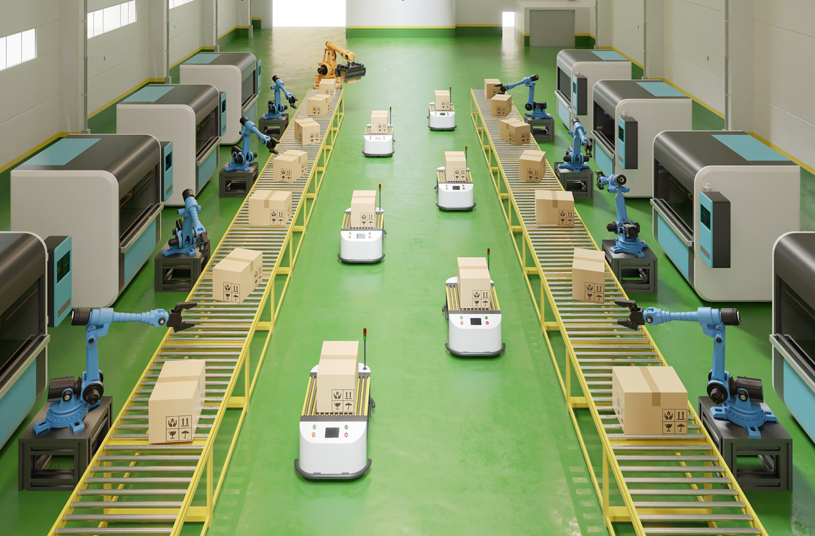Smart Logistics Are on the Move

Digitalization, the Internet of Things and artificial intelligence are rapidly remaking the logistics and supply chain sectors. The German market for international providers of logistics solutions is heating up – stoked by the coronavirus pandemic and growth in e-commerce.
For Swisslog, a Swiss provider of automated intralogistics technologies, 2021 was an important year. In April, about 250 employees of the German subsidiary moved to a larger compound within the city of Dortmund. Swisslog’s new site includes facilities for software development and a technology center for robotics. It also intends to expand its local workforce and is currently advertising almost a hundred open positions.
The company is readying itself for new opportunities in the German market, as demand for logistics solutions and services explodes. This will entail new forms of “smart logistics” and not just traditional expansions in terms of space and personnel.
Swisslog CEO Christian Baur characterizes the new site as “a sign of expansion and future orientation as well as a commitment to the Ruhr Valley metropolis and Germany.” And he’s not alone in thinking Germany is the place to be for the new logistics sector.
The Bottom Line
Micro-fulfillment, fully automated warehouses and item-picking robots – the need for innovative logistics concepts in Germany is huge. International logistics equipment suppliers and IT companies should take note.
A logistics Silicon Valley
US company Dematic, a supplier of intralogistics solutions, warehouse and logistics automation, also sees huge and growing prospects in Europe’s largest economy. “Germany is the Silicon Valley of intralogistics,” says Dematic’s MD Jens Hardenacke. Located in the heart of Europe, it serves as a think tank for intralogistics worldwide. “Germany has many well-trained specialists and they drive innovation forward.” Accordingly, the sector is one of the most dynamic markets in Germany.
“In logistics, location is key,” says David Chasdi, Senior Manager at Germany Trade & Invest (GTAI). “Germany, however, offers much more than just being the EU’s geographic center with easy access to some 500 million plus consumers. With Europe’s strongest economy and over 60,000 logistics companies large and small, Germany generates world-class logistics expertise and variety and is Europe’s number one logistics market generating EUR 280 billion revenue in 2020.”
An increasingly important subsector of this market is intralogistics or everything related to the logistical flow of goods, information and material within the walls of fulfillment or distribution centers.
2021 was a strong year for German materials handling and intralogistics suppliers. According to estimates, the production volume rose to EUR 22.6 billion, up 6 percent from 2020. Moreover, German logistics companies’ investments into IT and automation make the market very interesting for international providers.
Due to ever-increasing cost and efficiency pressures, many logistics companies in Germany are seeking innovative warehousing and supply chain solutions. The boom in e-commerce is causing retailers to rethink their operations, from inventory and dispatch to handling returns. “E-commerce is growing at double-digit rates and this is happening across almost all industries,” says Hardenacke.
Online food retailing in Germany is also developing fast and presents a special challenge for operators: The goods have to be retrieved from the warehouse, assembled to order and packaged in a durable manner before being delivered. One answer to the challenges that arise around the so-called “last mile” are micro-fulfillment solutions – highly automated storage that fits into the back room of a grocery store.
In the search for potential savings, large warehouse operators are also increasingly turning to robotics and even to fully automated warehouses. “As a result of the high labor costs, the demand for automation technology in Germany is particularly high. German labor safety regulations also play a role in the decision to automate,” says Hardenacke. “The dangerous part of warehouse work is increasingly being handed over to machines.”
AI and IoT
Artificial intelligence (AI) and the Internet of Things (IoT) are making robotics even more essential to cutting-edge logistics. One popular use for AI is order picking: Self-learning robots scan the goods, select the correct item and place it on the conveyor belt. In addition, Autonomous Mobile Robots (AMRs) cruise around the warehouse: Using cameras, IoT sensors and lasers, the AMRs recognize their surroundings and choose the most efficient route to dispatch.
“Customers in Germany are increasingly looking for flexible and mobile solutions,” says Hardenacke. “In some areas, conveyor belts are increasingly being replaced by autonomous mobile robots or driverless forklift trucks.” AI is also being used for predictive logistics, as monitoring global supply chains is crucial to limiting pandemic-related and other disruptions.

Source : marketsgermany.com



